Williamsburg
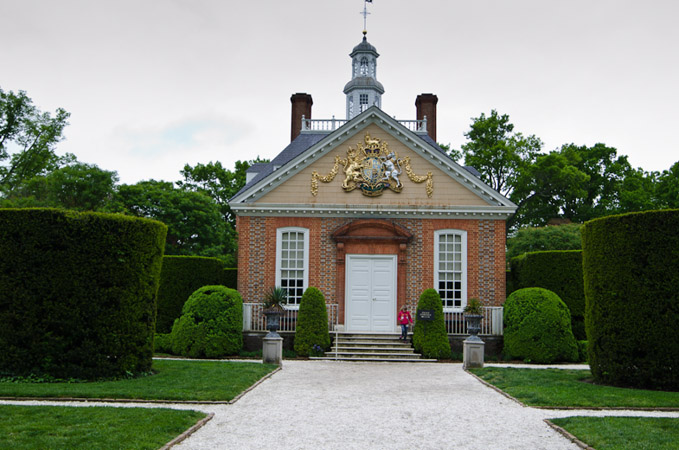 We started our day with a guided tour of the Governor's Palace. Only a few photos were taken inside the palace as most areas were off limits. Taxpayer money outfitted the interior in the highest of styles during that period.
We started our day with a guided tour of the Governor's Palace. Only a few photos were taken inside the palace as most areas were off limits. Taxpayer money outfitted the interior in the highest of styles during that period.
We stopped at the Everard House for a narrated tour. A woman, volunteer guide, indicated the house had been historically rebuilt. Extensive research found the original wallpaper under the crown molding. The molding was recreated along with the colors and techniques used to paint/shellac some of the walls.
The brick kitchen is a separate building, as upper class people did not want the smells or heat, it was originally built in wood, and back in the day covered with brick. An original brick veneer house. John D. Rockefeller Jr. (1874-1960) put up the money to buy much of the town and founded the Williamsburg Foundation that restored most of the town.
A stop at the Prentis book binding shop was absorbing, as book making was a labor intensive project. A quality book lies flat when opened. Bindings were hand sewn, a ten or twelve page 4"x3" booklet cost a half days wages. A full bound, upper quality, leather, full magazine size 200 page book would cost two weeks wages for an average man. You could lower the cost by going with a half bound book which would have inexpensive leather around the bindings and only the corners covered in leather. Cost would drop in half.
The proprietor, in conversation, positioned himself on the Loyalist side of the revolutionary war. He indicated that being a loyalist exposed him to beatings and taunting as a traitor. Revolutionaries were subject to none of this. He did not feel he  had the freedom to express his political position.
had the freedom to express his political position.
Freedom, he felt, was on the British side. The British Stamp Act of 1765 required that many printed materials (magazines, newspapers, legal documents, etc.) be produced on stamped paper produced in London carrying an embossed revenue stamp. With regard to taxes on paper and tea he indicated that paper in London was taxed at the equivalent of $200.00 and only $15.00 in America. The wealthy were the only ones paying the taxes, as they were the only ones who could afford the items the British were taxing.
The taxes were for the expenses during the French/Indian war (1754-1758) which was fought on the colonists behalf to obtain the Ohio farm land west of the line of demarcation. The demarcation line ran north and south from Maine to Florida on the western edge of the original colonies. England felt it was fair to tax for a portion of the war expenditures. The proprietor closed his oratory saying that all the men advocating revolution were wealthy land owners or people of high position and indicated it was something to think about.
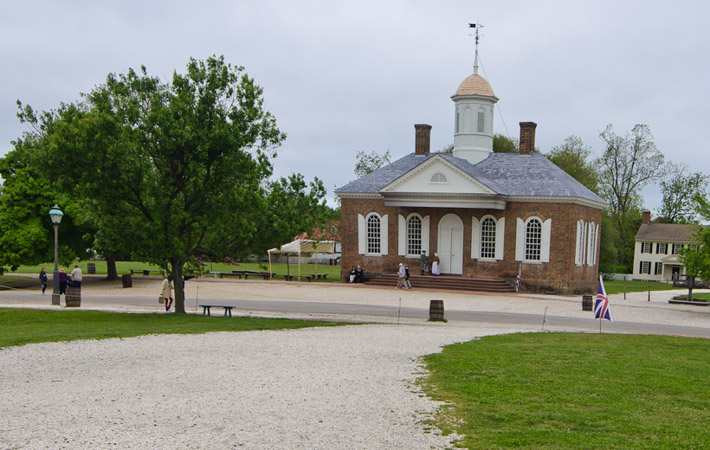
The courthouse tour was historically significant both in decor and circumstance. Historical paintings of the King and Queen of England are displayed, as the laws of the time were taken from England and the authority came from the King. The court house; period characters, put on a lower court mock trial of three different cases.
The lower court is analogous to our traffic and small claims court. One case involved a man who had not attended church at least once in the last four Sundays. You could see clearly why our constitution includes a separation of church and state.
The Magazine is where the weapons and powder were stored and located right in the central part of town. We obtained 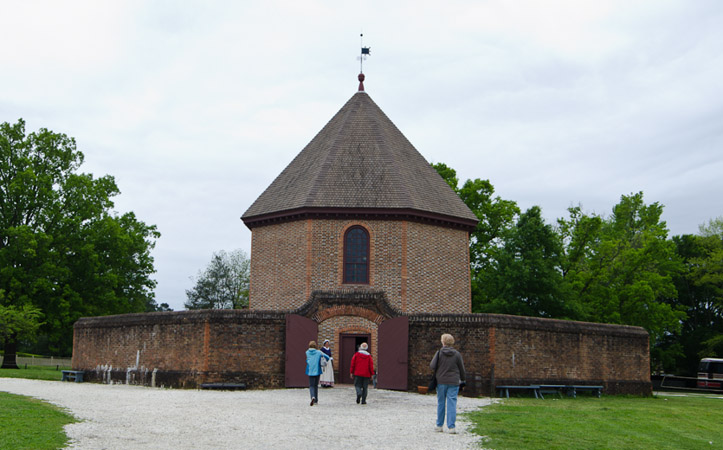 great photos of the Magazine's weapons and listened to a historical lecture captioning historical moments at the Magazine.
great photos of the Magazine's weapons and listened to a historical lecture captioning historical moments at the Magazine.
Particularly; when Lord Dunmore's troops stole a wagon load of powder from the Magazine. In the slideshow you will see a small 4" cannon and a very long rifle used for fort wall defense.
The muskets were of 75 caliber and shot a 69 caliber ball, smooth bore, and were extra long with a bayonet. The reason for the smaller lead ball was black powder leaves 50% of the spent powder in the barrel. If a 75 caliber ball was used it would require cleaning after just a few shots. The extra length was not for accuracy. The extra length was for using the bayonet in close quarters combat.
The rifle companies were set up in brigades of three companies each, and three brigades, right, left and 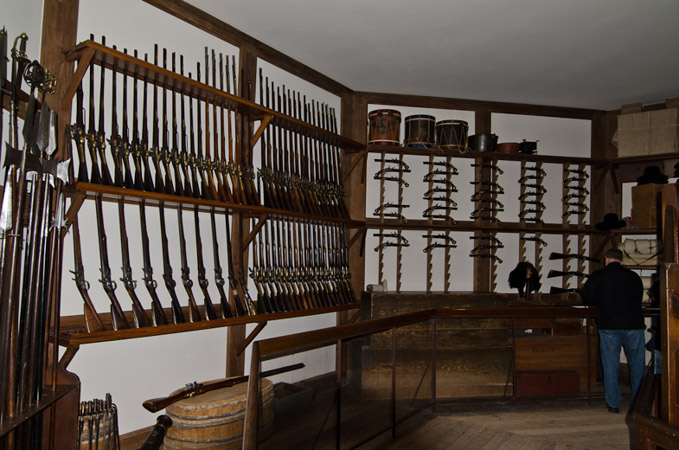 center. The brigades were set up to send a lot of lead downrange and allow others in the brigade to reload. The average rifleman was expected to fire his musket three times per minute, the best could do it four times.
center. The brigades were set up to send a lot of lead downrange and allow others in the brigade to reload. The average rifleman was expected to fire his musket three times per minute, the best could do it four times.
We had the opportunity to see the street play "The Cost Of Freedom" in front of the Raleigh Tavern. Wartime inflation had become unbearable. An angry crowd gathers to confront the crisis. Starting at 3:30pm and carried on to the start of "The Town Is Taken" in front of the Capitol building. Benedict Arnold rode in with a company of Dragoon Guards and the British occupied Williamsburg. Start to finish about an hour.
Our Capitol tour was historically fascinating late in the afternoon. The Capitol building was restored to its original condition after the capitol of Virginia was moved from Williamsburg to Richmond. The capitol was moved as it was felt that Richmond was better situated militarily, as it was further away from the James River.
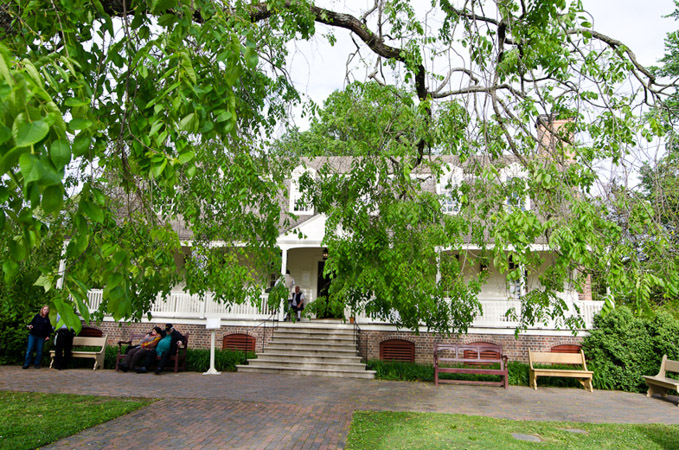 Dinner at Cristiana Campbell's Tavern, after the street play, fish stew with corn was excellent.
Dinner at Cristiana Campbell's Tavern, after the street play, fish stew with corn was excellent.
Our second day at Williamsburg started at Bassett Hall, built between 1753 and 1766 it derives its name from Burwell Bassett who lived there from 1800 to 1839. Mr. Bassett was Martha Washington's nephew. By the 1930's the town had become run down with many of the buildings scheduled for demolition.
John D. Rockefeller, Jr., (1874-1960) visited the town and became involved in the towns restoration. Originally spending seven million for architectural drawings and limited restorations, it creped up to sixty eight million, with the purchase of many of the historical homes and businesses. Mr. and Mrs. Rockefeller fell in love with Bassett Hall and had the home restored to its original condition.
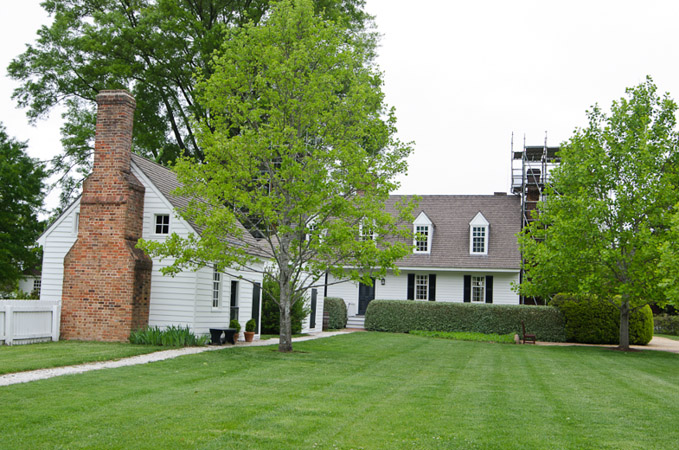
The Rockefeller's furnished the home with 18th and 19th century Chippendale, Federal, and Empire styles. The Rockefellers lived in the home in the mid 1930's for two months every year and considered the time spent there as normal, as opposed to their New York Park Avenue residence.
The home is now operated by the National Park Service and is open to the public.
To fill the rest of the day we visited the Randolph, Wythe, and Geddy Houses, Wetherburns Tavern and a shoemakers shop. We viewed street plays "Swordplay, A Lesson from the Fencing Master" and "A Court of Tar and Feathers" both in front of the Raleigh Tavern. We capped the day with a crab cake dinner in the Merchant Square district of Colonial Williamsburg. To start the slideshow click here.